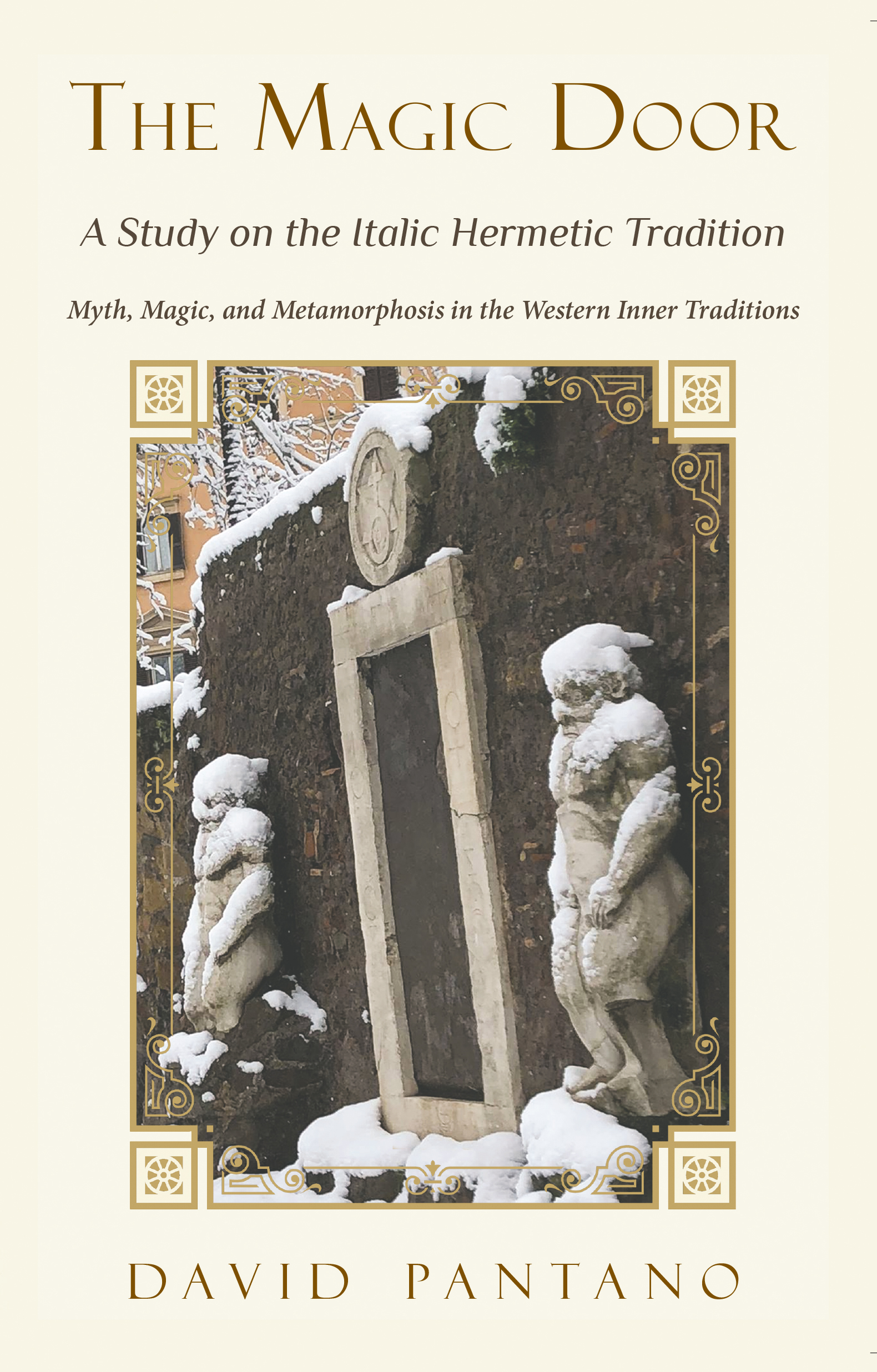
Gaetano Lo Monaco was born in Catania (Italy), where he presently lives and works. As an independent researcher in the field of esoteric-initiatory disciplines, he has collaborated with magazines such as Laòs, Merkur, Origini, Agorà, Atrium, & Luz and has written several essays on Giuliano Kremmerz and the “Italic-Egyptian” tradition, including a book on The Egyptian Osiris Order and the Pythagorean Transmission [1] and more recently with Giuliano Kremmerz and the French Occultism of the Second Half of the Nineteenth Century [2] in Octagon – The Search for Totality, edited by HT Hakl, Vol.III, Gaggenau, 2017. He is currently preparing a study on Arturo Reghini, Julius Evola and Italian esotericism in the early decades of the twentieth century, as well as other works on important themes of European occultism.
Republished with permission, original version available here (Italian).
The Magic Door – A Study on the Italic Hermetic Tradition: Myth, Magic and Metamorphosis in the Western Inner Traditions
David Pantano
 The text that we have the pleasure of reviewing by David Pantano, a Canadian scholar and independent researcher of Italian origin, should be considered as an absolute novelty for English-speaking readers of esoteric and traditional studies. For the vast majority of cases, these studies are limited within the historical and operational parameters of occult organizations such as the Blavatskyian Theosophical Society and the pseudo-Rosicrucian Golden Dawn and its various direct and indirect branches and/or emanations, Crowleyan and non-Crowley (Astrum Argentinum, BOTA, etc.,) alike.
The text that we have the pleasure of reviewing by David Pantano, a Canadian scholar and independent researcher of Italian origin, should be considered as an absolute novelty for English-speaking readers of esoteric and traditional studies. For the vast majority of cases, these studies are limited within the historical and operational parameters of occult organizations such as the Blavatskyian Theosophical Society and the pseudo-Rosicrucian Golden Dawn and its various direct and indirect branches and/or emanations, Crowleyan and non-Crowley (Astrum Argentinum, BOTA, etc.,) alike.
This text, however, points to something different. As stated on the back cover, “The Magic Door is a study on myth, magic and metamorphosis in the italic (Roman and Italian) branch of the Western Inner Traditions. The Magic Door surveys a wide spectrum of esoteric traditions and explores the heroes, schools and teachings that have laid the foundations for initiation in Italy, from Roman times to the present, in the broader context of an Occidental Tradition.” The Magic Door examines in a succinct manner an uniquely Italian-form of spirituality within the broader context of Western traditional studies.
Although there would be much to discuss on the problematic notion of an unbroken “historical continuity” of the ancient initiatory currents (which we will not address here). Still, Pantano’s text has the indisputable merit of illustrating, in an organic and systematic manner, the fundamental aspects of this particular “italic” strand of esoterism (as represented by historical proponents), of which little or nothing is known in the Anglo-Saxon world (except for the meritorious studies of the Austrian scholar, Hans Thomas Hakl, an expert on Evolian thought).
In the forty (highly symbolic number) chapters that structure this crucial text, the Italian-Canadian scholar lays out with great clarity and mastery the foundations of an “Italic based spirituality steeped in Olympian and Classical traditions, articulated through a mythopoetic framework, and incorporated into forms that attest to metamorphosis from human to the heroic (vir), and from the heroic to the sacred dimensions of the divine (divus) or conversely from human to the bestial (barbaric). The mythological narrative is privileged by the initiate for its power to feed the imagination. The imagination is the preferred champ de cultivation of self transformation, due to its plasticity that renders the emotional and psychic structures conducive to metamorphosis more so than the somatic or hylic levels of being that are weighed down by dense laws of stasis and habitual recidivism. By harnessing the imagination (in-mag-inatio), the initiate releases conscious energies from the bonds of external senses to channel awareness inwards and clear consciousness from recurring loops of mental patterns to reservoir in a state of emptiness (void). However, it is by the skilled hand of the artist that the most vivid testimonies of the divine are rendered earthly. It is through the exercise of Bacchic or Dionysian arts, that artists pierce the quotidian and enter into ecstatic and/or enstatic states to cultivate spiritual light and yield beatific visions that translate into works of creation, mirroring Giambattista Vico’s eternal principle: “Verum-factum, truth is what is created”.
Essentially, the “italic” initiatory tradition, writes Pantano, “is rooted in a vision of life that is spiritual in nature and hence Hermetic in practice. The Hermetic forma mentis sees life as an all-encompassing and inter-connected whole by virtue of the original One (Principle). As the well-known phrase from the Emerald Tablet of Hermes suggests “As it is above, so it is below”, there is an emanational continuity linking the Macrocosm with the Microcosm where every one-thing is connected with every other thing through the agency of the spirit. Hence the hermetic transmutational science “consists of the virtual passage from one state of being to another […]”. (In) the Italic tradition, initiation is best symbolized by the Magic Door, which the ancient Romans consecrated to the patronage of Janus who presides over the safe passage through gateways from the point of entry to the point of exit or from one threshold to another. Therefore, it is of no coincidence that this text is entitled The Magic Door, for the author indicates by this title the realized transformation from one state of being to another, as well as, to reference the historic “Porta Magica”, the famous gate built around 1680 by the alchemist Marquis Massimiliano Palombara (1614-1685) at his villa on the Esquiline Hill – which still stands in the gardens of Piazza Vittorio Emanuele II in Rome. Among a host of curious insights and interpretations, the author reports on an alchemical-magical exegesis of the symbols and inscriptions carved on the Porta Magica and written by the Neapolitan hermeticist Giuliano Kremmerz (aka Ciro Formisano,1861-1930) – a leading exponent of the so-called “Italic-Egyptian” initiatory current – in his homonymously titled work, The Hermetic Door (La Porta Ermetica, 1910). Pantano devotes the necessary space, to elaborate on the significance of Kremmerz and the organization that he created, the Magical-Therapeutic Fraternity of Myriam, one of the major Italian esoteric sodalities of the 20th century, as well as his indirect and direct precursors (Giambattista Vico, Cagliostro, Domenico Bocchini and Giustiniano Lebano).
Likewise, in the third and fourth parts of his book, other Italian occult cenacles of the twentieth century are properly treated, that more or less openly identify with Italian hermeticism, such as the Group of Ur (with reference to the Schola Italica by Amedeo Rocco Armentano [1886-1966] and Arturo Reghini [1878-1946]) and the Corpo dei Pari (Body of Peers), an esoteric circle formed in the early 1960s by the lawyer, Giammaria Gonella (1924) around the enigmatic figure of Baron Ricciardo Ricciardelli (aka Marco Daffi), a frequent acquaintance of Kremmerz in the 1920s. Of particular interest is the final section devoted to the Golden Verses of Pythagoras, the analysis of initiatory symbolism of the “Golden Bough” and on certain aspects of Orphic-Dionysian initiation, all important topics inextricably linked to the fundamental chapters constituting the first and second sections of the text that discusses the origins, formation and unfolding over the centuries of the so-called “Italian tradition”, and referenced through the multi-levelled contexts and key protagonists of the Latin and Italian cultures (Cicero, Ovid, Virgil, Simmachus, Dante, Ficino, Campanella etc.).
In conclusion, to echo what was said in the premise of this review, The Magic Door by David Pantano – and it should be noted, beautifully illustrated by Josef Stefanka – is an absolute novelty in the English-speaking esoteric landscape that now thanks to this work will serve as an indispensable pool of knowledge to discover and deepen pregnant themes and enigmatic problems related to the Italian Hermetic Wisdom and its peculiar reflections within the Universal Tradition.
This study is strongly recommended to the public at large as well as the Italian reader (who has a decent familiarity with the Albion(ic) language), to those who profess a simple curiosity or those who are serious readers of this subject matter.
[1] L’Ordine Osiride Egizio e la Trasmissione Pitagorica – Nove, [VI], 1999
[2] Giuliano Kremmerz e l’Occultismo francese della seconda metà del XIX secolo


